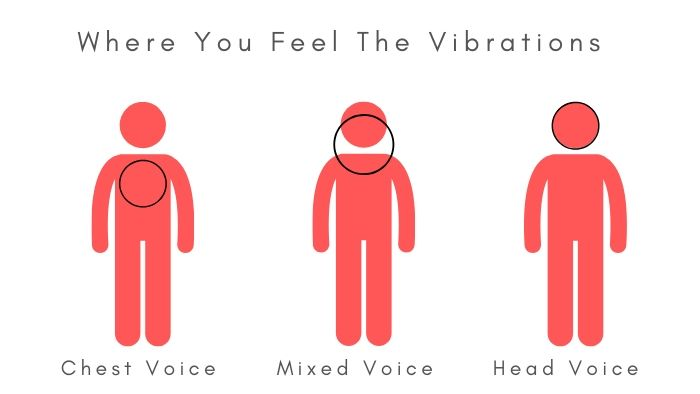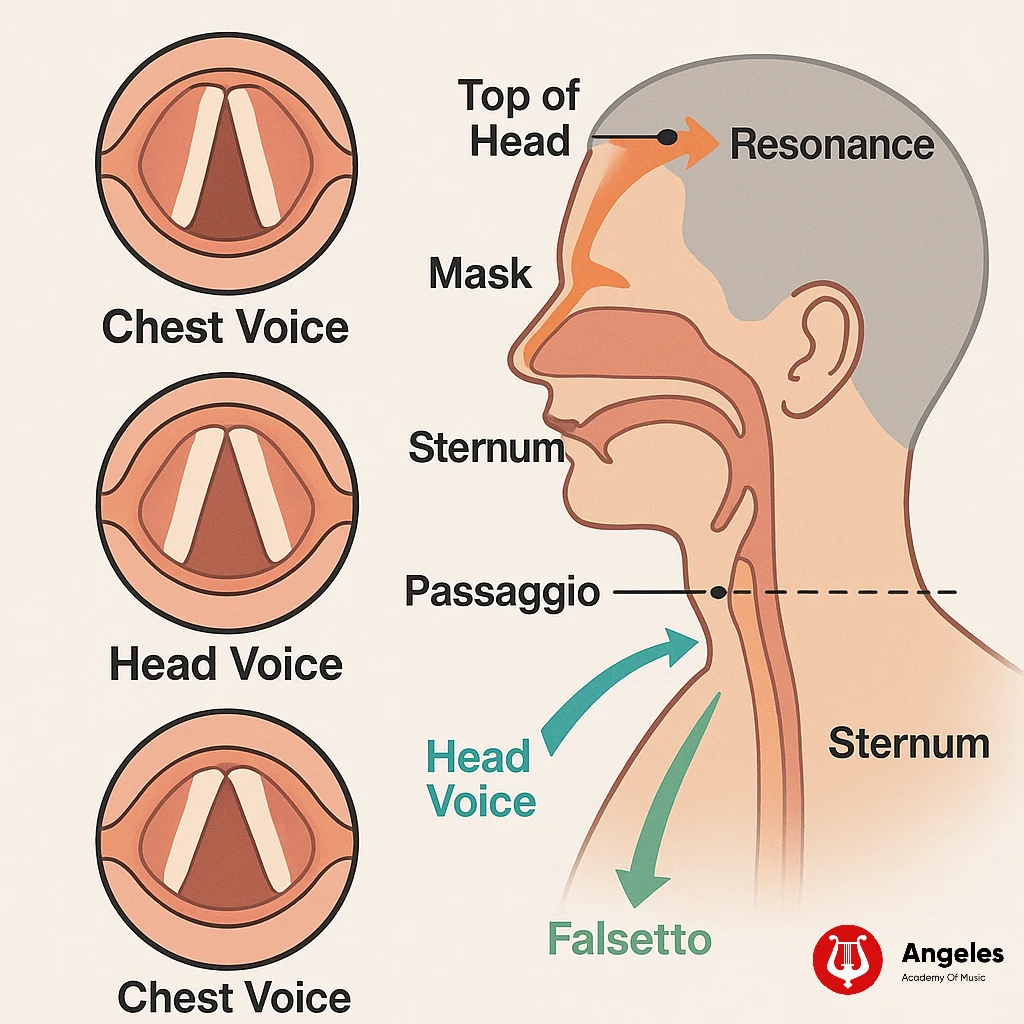Everyone wants to sing like Ariana Grande, Bruno Mars, or Freddie Mercury, but few stop to ask: What on earth is going on inside my voice when I try to hit those notes?
What on earth is happening inside my voice when I try to reach those notes? The answer lies in understanding vocal registers: what is falsetto vs head voice vs chest voice?
Here’s the deal. These words aren’t just pretentious jargon from music nerds. These vocal modes describe distinct ways that our vocal folds and resonators work together to create sound.
They explain why some notes feel grounded and warm while others float out of you like you just inhaled helium.
If you get this, you stop stabbing at high notes in the dark and start steering your voice like a Formula One driver. Whether you’re a hobbyist singing in the car, a Broadway hopeful, or a pop star secretly stalking this article (hi, Billie), understanding your registers is non-negotiable.
(Pro tip: if your dream is to actually learn this stuff in real time, check out our voice lessons at Angeles Academy of Music. A good teacher will save you months of guesswork.)
Before we get into the main topic, let us address a few of the most common doubts parents have. Let’s get the confusion out of the way, and then approach with an open mind.
Parents FAQs (Skip if you’re not a parent)
My child sounds “shouty” in chest voice — is that harmful?
No, shouting isn’t the goal of chest voice. When guided by a teacher, chest voice is trained to stay strong but relaxed. Lessons help kids learn safe breath support so their voice grows powerful without strain.
Should I be worried if my child can’t reach head voice yet?
Not at all. Head voice develops gradually, like flexibility in sports. Most children find it over time with the right exercises.
Is falsetto dangerous for kids?
No. Falsetto is simply a lighter coordination of the vocal folds. It’s safe when not forced, and teachers often use it to introduce high notes gently.
What is a Chest Voice?
Chest voice is where most of us live. It’s the speaking range, the sturdy, earthy place you use to belt your favorite rock chorus. Anatomically, your thyroarytenoid muscles are thickening the vocal folds so they vibrate with full contact.
That’s why you feel a buzz in your chest or sternum when you hum a low note.
Think of it as your vocal “root chakra”: grounded, steady, confident. Freddie Mercury’s low swagger in “Somebody to Love” is a masterclass in chest resonance.
How to Sing in Chest Voice
- Start Where You Speak
Begin on a note close to your speaking pitch—usually in the lower or middle range of your voice. Say “hello” out loud, then sing that same pitch on a long “ah.” This anchors you in the chest register
- Feel the Vibration
Place a hand on your sternum or upper ribs. As you sing a low, sustained note, notice the buzz or warmth under your palm. That resonance means you’re engaging the thick, full closure of the vocal folds that define chest voice.

- Support With Breath
Keep your ribcage lifted and your abdominal muscles gently engaged. Good breath support keeps your sound rich without forcing. If you push from your throat, stop—reset your posture and breathe deeply before trying again.
- Expand Gradually
Practice simple scales (five-note or octave slides) on open vowels like “ah,” “eh,” or “oh.” Move upward a few notes at a time, maintaining a solid, warm tone. Don’t drag chest voice past its natural limit—when you feel tightness, it’s time to transition to head voice.
- Stay Relaxed
A tense jaw or raised shoulders will choke off resonance. Keep everything loose while you let the chest voice vibrate freely.
But here’s where beginners trip: they drag chest voice too far up, like trying to sprint uphill in steel boots. The throat tightens, notes crack, and your neighbors consider moving.
Instead, learn where your chest voice likes to stop. Warm it up with steady breath support and scales. Don’t muscle it higher than it wants to go.
(Need tools? Our vocal warm-ups guide is a great place to start.)
Head Voice: The Secret Room Upstairs
Now we leave the living room and climb the stairs. Head voice is lighter, brighter—like your tone just discovered gravity doesn’t apply. Your cricothyroid muscles stretch the folds thin while still closing them, producing a ringing clarity.
If chest voice is espresso, head voice is champagne. Ariana Grande’s crystal high notes or Sam Smith’s soaring phrases? That’s head voice on display.
How to Sing in a Head Voice
- Find Your Start PointBegin a few notes above your speaking range, usually mid to high on the piano.
- Light OnsetUse an “ee” or “oo” and let the sound float forward, like sighing. Avoid pushing or gripping your throat.
- Feel the PlacementHead voice resonates higher. In the face, forehead, or crown. A gentle “ping” sensation is a good sign.

- Stay SupportedKeep ribs lifted, abs lightly engaged. Airflow should be steady but not forced.
- Sirens & SlidesGlide from low to high on “ng,” “woo,” or “hee,” aiming for a smooth switch from chest to head.
- Volume LastBuild strength gradually; start soft, then add power as the tone stays clear.
- Stay LooseKeep jaw, tongue, and shoulders relaxed. Tension cuts resonance.
- Practice OftenShort daily reps beat marathon sessions. Consistency helps you own your head voice safely.
Many students shy away because it feels foreign. “It sounds too nasal!” they panic. Relax. That’s your internal microphone lying to you. Out in the room, head voice is often the most beautiful thing you’ve ever produced. Start with gentle “hee” or “oo” slides, keep the breath steady, and allow the sound to ping forward into your face.
(Bonus read: Breathing techniques for singing help you keep the airflow clean so your high notes don’t wobble.)

What is a Falsetto (The Airy Cousin)
Falsetto is that silky, flute-like sound Justin Bieber or Billie Eilish use when they want intimacy. Physiologically, only the edges of your vocal folds vibrate, leaving a small gap. The result: a soft, floaty timbre that sits above head voice.
Unlike head voice (which keeps the folds fully closed), falsetto has partial closure and less overtones, which is why it sounds breathier.
Falsetto isn’t “cheating.” It’s a legit register. One you can strengthen or blend with head voice for a fuller tone. Bruno Mars flips between head and falsetto on “Versace on the Floor” like it’s nothing.
How to Sing in Falsetto?
For beginners, start on a high “hoo,” (like a literal hoot or how people say woohoo!!!) keep it light, and resist the urge to push volume. Falsetto thrives on gentleness. Later, you can sneak in firmer closure to get a stronger, “reinforced” falsetto.
Or follow her instructions:
Under the Hood: Anatomy and Diagrams
Let’s peel back the curtain. Singing isn’t mystical fairy dust. It’s biomechanics plus breath plus a pinch of attitude.
- Chest Voice: TA muscles (thyroarytenoid) shorten and bulk the folds so they vibrate fully.
- Head Voice: CT muscles (cricothyroid) stretch the folds thinner, but they still meet cleanly, giving you clarity without strain.
- Falsetto: Only the outer edges of the folds vibrate, leaving an air gap. That’s why falsetto feels featherlight.
Imagine three sliders on a mixing board: thickness, length, closure. Chest = thick & full closure. Head = thinner, still closed. Falsetto = super thin, slightly open.

Remember, most of the time you’ll be using head voice and chest voice only, keep it 80% chest and head voice vs falsetto the other 20% of the time.
How to Train Without Breaking Your Voice
Good news: you don’t need to be Freddie Mercury reincarnated to master registers. You just need patience, smart reps, and someone to call you out when you’re pushing instead of singing.
The goal is that listeners (and you) barely notice the switch. This builds coordination so chest and head connect seamlessly. So, instead of choosing between chest voice vs head voice, this technique helps you sing in both.
Drills and Support
Use lip trills, gentle humming, and octave slides to connect registers safely. These encourage steady airflow and fold vibration without tension.
Always maintain good posture and strong breath support: stand tall with shoulders relaxed, and engage your diaphragm. (Tip: Begin each practice with gentle vocal warm-ups and mindful breathing techniques to prepare your instrument.)
Want to tie it all together? Mix voice is the Swiss Army knife. Try gentle “nay” or “gee” on 5-tone scales, letting chest and head share the load. Over time, you’ll bridge registers without the dreaded goat-yodel crack.
(Need a coach to make sure you’re not just screaming into the void? Sign up for vocal lessons. Our teachers specialize in helping singers of every level find a balanced, sustainable tone.)
The Psychology of Registers
Here’s where years of teaching come in: most people’s biggest hurdle isn’t muscle, it’s mindset.
- Beginners panic when their voice flips. They assume they “can’t sing.” Reality: you just hit the gear shift too fast.
- Hobbyists often baby their falsetto, treating it as fragile. It’s not. It just needs structured reps.
- Advanced singers sometimes obsess over perfection, choking off natural freedom.
Mark this truth somewhere big: your passaggio is not a villain, it’s a doorway.
Treat each register as a different room in your house. Chest is your kitchen: solid, practical. Head voice is the sunlit upstairs. Falsetto is the quiet balcony where you sip coffee at 2 AM. Master them all, and you own the whole building.
How Skill Level Shapes the Journey
No matter where you stand on the singing spectrum, registers evolve with you:
Beginners & Hobbyists
Focus on healthy basics first: clean tone, good posture, and steady breath. Stay in your chest/mid range until those are solid. Gradually introduce head tones.
For example, start by humming on high pitches or singing easy scales into head voice. Use songs you love for motivation; singing along will train your ear and make practice fun. Remember, it’s common to feel that high notes are scary at first.
Advanced Singers
Work on extending your range and mixing registers. Tackle challenging repertoire and notice how professionals handle it. For example, practice an Ariana Grande riff and observe how she transitions smoothly; then try to emulate that transition.

Technical drills (arpeggios, wide intervals) help stretch your range. A balanced mixed voice – smoothly blending chest and head, lets you hit high notes powerfully without strain.
Professionals
Use registers as expressive tools. In performance, belt with chest voice for impact, and switch to head or falsetto for nuanced moments. Freddie Mercury’s enormous range (from F2 to F6) was built on a powerful chest/head mix.
Billie Eilish’s intimate style relies on an airy head/falsetto sound. Your style and genre will influence how you deploy these registers.
Whatever your level, be patient. Rome wasn’t built in a day, and neither is a seamless F5.
(If you’ve been wondering whether it’s “too late” to get serious about singing, it’s not—read Too Late for Singing Lessons in Los Angeles. Spoiler: your voice doesn’t care how old you are.)
Use Registers to Express!!!
Chest voice feels grounded. Your sonic handshake with the world. Head voice? It’s the part that lets you dream out loud. Falsetto is vulnerability, a quiet confession you send into the dark.
I’ve seen students stand taller after nailing a single high note. I’ve seen shy teens find their identity in a perfect falsetto phrase. Singing isn’t just mechanics. It’s self-discovery, resilience, and a dash of mischief.

When you practice, don’t just chase “perfect technique.” Chase what it feels like to fully inhabit a sound. That emotional layer is where songs come alive.
Your Next Move
If this guide lit a fire under you, don’t let it fizzle out. Work your registers daily: short, smart sessions beat marathon throat abuse. Keep a playful attitude, track your wins, forgive your slips.
Mastering falsetto vs head voice vs chest voice is more than collecting notes; it’s claiming your own sonic territory.
When you balance head vs chest voice, fold in a touch of falsetto, and explore every register, you give yourself permission to sound free. Own it. Play with it.
And remember: every brilliant singer once stood exactly where you are, curious, unsure, and ready to discover what their voice could really do.
And if you want expert eyes and ears helping you shape that sound, book a voice lesson with us at Angeles Academy of Music. Whether you’re aiming for casual karaoke glory or the next big stage, we’ll help you navigate chest, head, and falsetto safely, and creatively.
Contributed by: Marina G, (BM, UCLA: University of California Los Angeles, Vocal Performance) (Angeles Academy of Music - Senior Voice Instructor)
.svg)
.svg)
.svg)
.svg)
.svg)
.svg)





.svg)